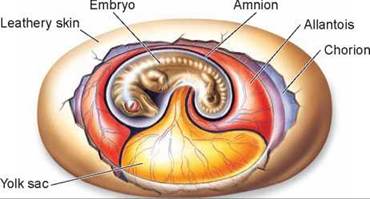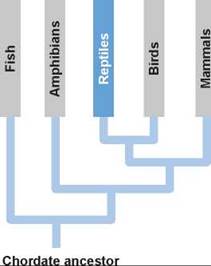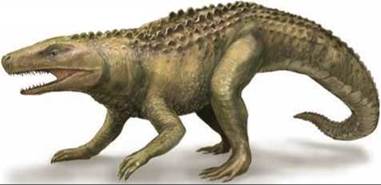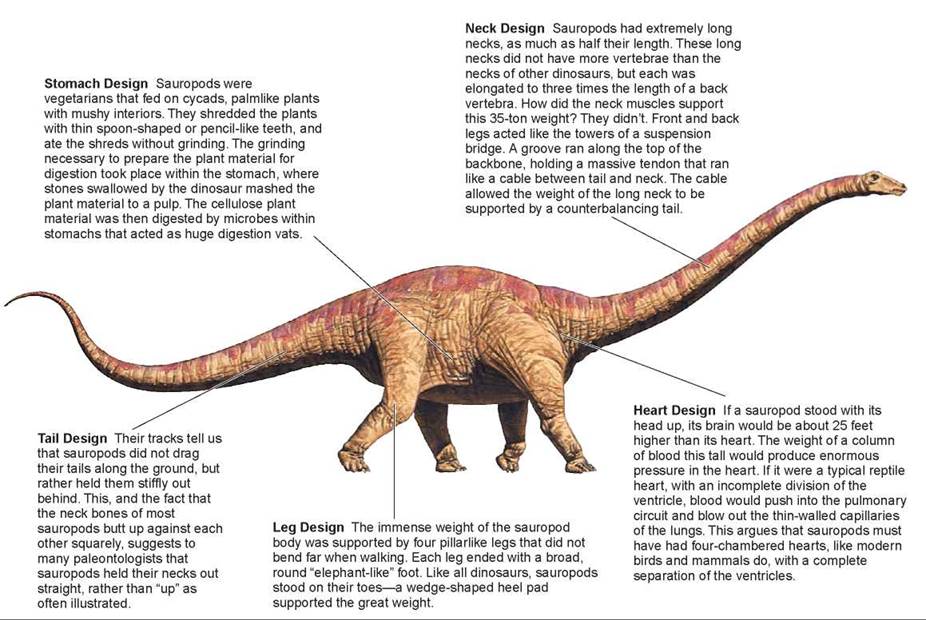THE LIVING WORLD
Unit Five. Evolution of Animal Life
20. History of the Vertebrates
20.6. Reptiles Conquer the Land
Characteristics of Reptiles
If we think of amphibians as the “first draft” of a manuscript about survival on land, then reptiles were the published book. All living reptiles share certain fundamental characteristics, features they retained from the time when they replaced amphibians as the dominant terrestrial vertebrates. Among the most important are:
1. Amniotic egg. Amphibians never succeeded in becoming fully terrestrial because amphibian eggs must be laid in water to avoid drying out. Most reptiles lay watertight eggs that offer various layers of protection from drying out. The reptilian amniotic egg (figure 20.18) contains a food source (the yolk) and a series of four membranes—the chorion (the outermost layer), the amnion (the membrane surrounding the embryo), the yolk sac (containing the yolk), and the allantois (the red structure).

Figure 20.18. The watertight egg.
The watertight amniotic egg allows reptiles to live in a wide variety of terrestrial habitats.
2. Dry skin. Amphibians have a moist skin and must remain in moist places to avoid drying out. In reptiles, a layer of scales or armor covers their bodies, preventing water loss.
3. Thoracic breathing. Amphibians breathe by squeezing their throat to pump air into their lungs; this limits their breathing capacity to the volume of their mouth. Reptiles developed thoracic breathing, expanding and contracting the rib cage to suck air into the lungs and then force it out.

In addition, reptiles improved on the innovations first attempted by amphibians. Legs were arranged to more effectively support the body’s weight, allowing reptile bodies to be bigger and to run. Also, the lungs and heart were altered to make them far more efficient. Today some 7,000 species in the class Reptilia (table 20.4) are found in practically every wet and dry habitat on earth. Modern reptiles include four groups: turtles and tortoises, crocodiles and alligators, snakes and lizards, and tuataras.
TABLE 20.4. ORDERS OF REPTILES

History of Reptiles
Reptiles first evolved about 300 million years ago when the world was entering a long, dry period. At about this time, three lineages of reptiles formed. In one lineage, “sail-back” pelycosaurs (see figure 20.4) rose to prominence. With long, sharp “steak knife” teeth, pelycosaurs were the first land vertebrates able to kill animals their own size. Pelycosaurs were dominant for 50 million years, at their height comprising 70% of all land vertebrates. The therapsids (see figure 20.22) replaced the pelycosaurs about 250 million years ago and had a more upright stance than the sprawling pelycosaurs. For 20 million years, therapsids were the dominant land vertebrate. Around 170 million years ago, most therapsids became extinct, but one group survived and eventually gave rise to the mammals.
A second lineage diverged and eventually gave rise to the ancestors of turtles around 200 million years ago. Turtles have remained largely unchanged since the Triassic, making them a very ancient reptile lineage.
As therapsids were becoming less common around 230 million years ago, a third lineage of reptiles gave rise to the ancestors of snakes, lizards, and tuataras, to marine reptiles, the ichthyosaurs and plesiosaurs, and to the archo- saurs. Early archosaurs resembled crocodiles (figure 20.19), but later forms called thecodonts were the first reptiles to be bipedal—to stand on two feet. Early archosaurs rose to prominence during the Triassic and eventually gave rise to four significant groups: dinosaurs, a very diverse group, some of which grew to be larger than houses; crocodiles, which have changed little from that time until now; pterosaurs, which were flying reptiles; and birds, about which we will have more to say. Dinosaurs were the most successful of all land vertebrates, but around 65 million years ago, they became extinct, along with the marine reptiles and pterosaurs.

Figure 20.19. An early archosaur.
Euparkeria, a thecodont, had rows of bony plates along the sides of the backbone, as seen in modern crocodiles and alligators.
Key Learning Outcome 20.6. Reptiles have three characteristics that suit them well for life on land: a watertight (amniotic) egg, dry skin, and thoracic breathing.
A Closer Look
Dinosaurs
Dinosaurs are the most successful of all terrestrial vertebrates. Dinosaurs dominated life on land for 150 million years, an almost unimaginably long time— for comparison, humans have been on earth only 1 million years. During their long history, dinosaurs changed a great deal, because the world they lived in changed—the world's continents moved, radically altering the earth's climates. Thus, we cannot study dinosaurs as if they were a particular kind of animal, describing one "type” that is representative of the group. Rather, we have to look at dinosaurs more as a "story,” a long parade of change and adaptation.
Origin of Dinosaurs
The first dinosaurs evolved from thecodonts, a crocodilelike group of now-extinct meat-eating reptiles. The oldest dinosaurs of which we have any clear evidence left their fossils in late Triassic period rock in Argentina, some 235 million years ago. These early dinosaurs, all meat-eaters, were the first vertebrates to exhibit the key dinosaurian improvement in body design—their legs are positioned directly under the body, allowing them to run swiftly after prey.
Golden Age of Dinosaurs
The Jurassic period (from 213 to 144 million years ago) is called the "Golden Age” of dinosaurs, because of the variety and abundance of dinosaurs that lived during this time. Among the largest land animals of all time, giant sauropods were the dominant herbivores (plant eaters). Some weighed 55 tons, stood over 10 meters tall (about 35 feet), and were over 30 meters long (about 100 feet), longer than a basketball court! They had enormous barrel-shaped bodies with heavy columnlike legs, and very long necks and tails.
By the late Jurassic, very sophisticated carnivorous theropods (flesh-eating dinosaurs) had evolved. Bipedal, Stomach Design Sauropods were vegetarians that fed on cycads, palmlike plants with mushy interiors. They shredded the plants with thin spoon-shaped or pencil-like teeth, and ate the shreds without grinding. The grinding necessary to prepare the plant material for digestion took place within the stomach, where stones swallowed by the dinosaur mashed the plant material to a pulp. The cellulose plant material was then digested by microbes within stomachs that acted as huge digestion vats with powerful legs, short arms, and a big head, theropods were well-suited for rapid running and a quick, slashing attack. Velociraptor, with the largest brain for body size of any dinosaur, was a highly effective predator, killing its prey with a large, razor-sharp claw on its rear feet. Tyrannosaurus had one of the largest brains in the animal kingdom, was one of the largest land predators ever known, and had a massive skull with large, 8-inch teeth.

Body design of a sauropod.
Triumph of the Chewers
With the rise of angiosperm plants at the beginning of the Cretaceous period (from 144 to 65 million years ago), sauropods were replaced by plant-eating dinosaurs with "chewing” teeth. The jaws of Iguanodon, Triceratops, and Hadrosaurus contain enormous batteries of grinding teeth that shred, pound, and grind even the toughest angiosperms. As long as 30 feet and weighing up to 5 tons, many of these chewing dinosaurs were larger than a modern battle tank.
Extinction of the Dinosaurs
65 million years ago all dinosaurs disappear from the fossil record. What caused the sudden extinction of the dinosaurs, after 150 million years of success? Most biologists now agree that the most likely cause was the impact of a gigantic meteor (it appears to have been 5-10 miles across!) off the coast of Yucatan. The impact created a huge crater 185 miles in diameter, throwing massive amounts of material into the atmosphere that would have blocked out all sunlight for a considerable period of time, creating a world-wide period of low temperature. Insulated with feathers or fur, warm-blooded (endothermic) birds and mammals survived, and coldblooded (ectothermic) reptiles and amphibians did too— cold-blooded animals simply lower their activity levels. However, most if not all Cretaceous dinosaurs appear to have been warm-blooded, biologists now believe, but with no insulation, they had no way to retain body heat in the period of intense cold after the meteor impact.

Body design of a theropod.